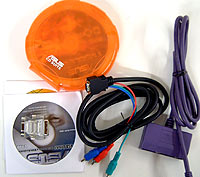Asus eXtreme EAX600XT Videocard Review
When it
comes to videocards, a souped-up deluxe version that caters towards enthusiasts
is usually the best bet. This is all well and good, but sometimes just a few
extra features are all we really need. Overclocking is nice, but with a
videocard forming the basis of a home theatre system, overclocking isn't a very
important consideration. With that in mind, PCstats will be putting the Asus eXtreme EAX600XT videocard through its paces today. The card is
based on the ATI Radeon X600XT graphics processor, which allows it to bridge the gap between
PC and home entertainment with a little thing we like to call
'HDTV.'
Component-out (Y, Pb, Pr) is a cool feature whose time as
come. Before this technology was available from a videocard, users relied upon
TV-output. Seeing as a composite or s-video connection has never really produced
a very crisp image on TV screens, a lot of home theatre enthusiasts have been
eagerly looking forward to HDTV component output. Of course, there's more
to this PCI Express videocard than an HDTV cables; the Asus eXtreme EAX600XT can
also handle full VIVO (Video In/Video Out) which is great for anyone who wants
to stream video into their PC, do record movies into
digital form. The Asus eXtreme EAX600XT retails for
about $215USD through online stores, so it is pretty affordable
too.
 |
|
Asus eXtreme
EAX600XT |
|
|

 |
| Includes: |
|
Quick Installation Guide, Driver CD,
Manual CD, Deus Ex: Invisible War, Asus DVD, Media @ Show,
PowerDirector, Ulead Cool 3D, Component Out Cable, VIVO Break
Out Box, DVI to analog converter |
 | | |
The layout of the Asus EAX600XT is very similar to that
of several other X600XT videocards to cross PCstats test bench,
but differs with the addition of the special black HDTV connector
where an analog monitor cable would typically go. This connector hooks up to 6'
long component cable that will reach to near-by HDTV compatible displays.
 The Asus
EAX600XT utilizes a one piece cooling solution on the front of the card which cools both the Radeon
X600XT core and memory. There is no cooling solution for the memory on the back
of the PCB however.
The Asus
EAX600XT utilizes a one piece cooling solution on the front of the card which cools both the Radeon
X600XT core and memory. There is no cooling solution for the memory on the back
of the PCB however.
The fan lights up
in a nice shade of blue once the system is turned on, and also manages to
create quite a bit of noise! In fact, you'll probably hear a low pitch hum even
after you've installed this videocard into a case, though it fades into
the background noise quickly.
In addition to the component output cables, it's good to
see Asus include everything users will needed to take advantage of the multimedia features of
the eXtreme EAX600XT graphics card. The component video cable is 2m (6') in length
which should be good enough for you to hide the PC away. A standard purple ATi
break out box is great for those who want to hook this videocard up to a standard
TV, or do a bit of video editing.
 The
Difference Between HDTV and S-Video
The
Difference Between HDTV and S-Video
These days it's pretty standard for a videocard to support
TV-Output. With ATI's new support of the HDTV standard, we're now starting
to see videocards based on the Radeon emerge with component output (y, Pb,
Pr) instead of just the usually accompaniment of s-video and composite (RCA)
cables.
For comparisons sake we're going to show you
the difference between traditional S-Video output of a computer desktop to a
TV screen, and the higher quality component output. We're not going to go into
all the detail of why component output is better, or what is supposed to
be happening with HDTV, as that is beyond the scope of this review. Suffice to say, below are two side by side screen
captures which illustrate the potential of component output to an HDTV capable
screen in place of the old videocard s-video output.

On the left is component (Y, Pb, Pr) output, on the
right is S-Video. As you can clearly see the text and even image (look at the
ATi logo) is much sharper and crisper because of the the use of the component
output feature. Component is clearer, and the s-video equivalent is noticeably
blurred.

